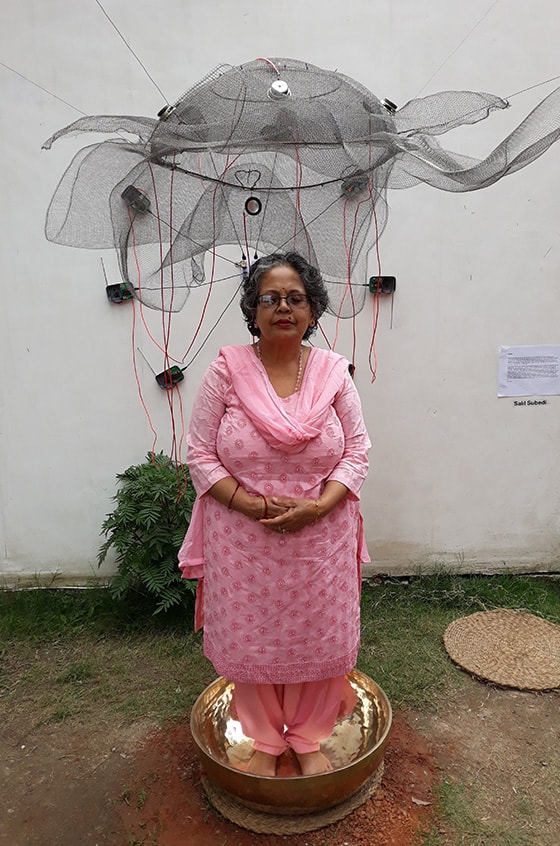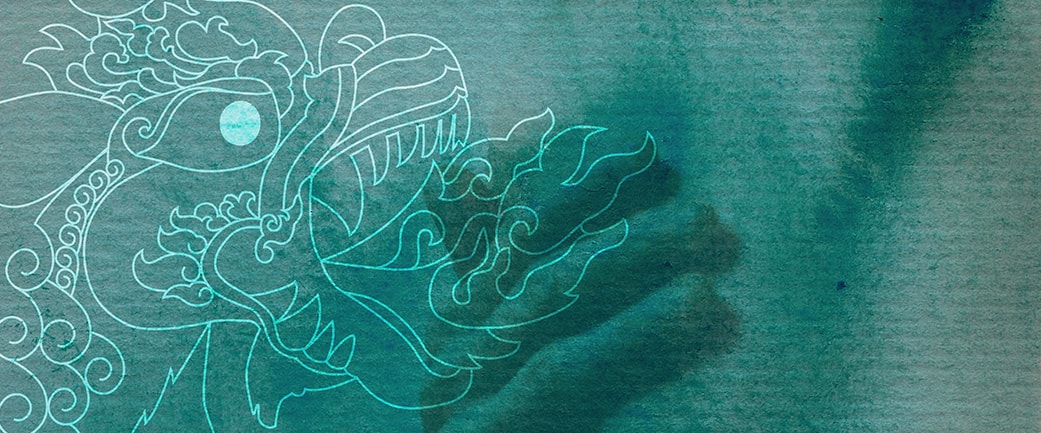
How artists in Nepal help foster healing and bring a sense of inner peace
Art has been linked with cultivating well-being since ancient times. In an age-old Nepali practice, healers would draw lions on rashes. The lions””made from varied colors with different chemical properties””would engulf the offending shingles and alleviate this skin ailment. People are more dependent on allopathic practices nowadays, but the concept of healing through contemporary art is becoming increasingly prevalent in Nepal, particularly in the aftermath of the 2015 earthquake.

I myself experienced the power of art to change one’s outlook and restore emotional balance in 2018 when I visited the group exhibition Sight and Sound at Gallery MCube in Patan. Salil Subedi’s sound installation looked like an alien object””a wire-mesh disc suspended in the air with several small speakers broadcasting various radio FM channels and emitting a jarring cacophony of noise. On the ground below the suspended disc, on a round patch of organic red mud, was a huge singing bowl of the same size, representing our direct connection to the earth.
The artist invited me to step into the bowl and asked me to relax despite the noisy ambience, which I found quite disturbing. I had to resist the urge to step out. Just then he swirled the pestle around the outside edge of the bowl and struck it hard. The vibrations of the bowl swept over me, instantly calming and grounding me, and I was enveloped by a sublime connection with the earth. The radio noise vanished, and there was absolute stillness in and around my body and my mind. With tranquility seeping in, I experienced how art can connect us to a sense of inner peace and foster healing despite the chaos around us.
I first met Salil when he was working as a journalist at the turn of the century. Learning of the healing potential of the didgeridoo, a wind instrument developed by the aboriginal people of northern Australia that produces a powerful repertoire of overtones and sound vibrations through various breathing techniques, Salil self-taught himself the instrument. He subsequently gave up smoking, restored his physical and mental health, and found his life’s quest as a performing artist. This transformation and ensuing contentment inspired him to heal others through his artistic practices.

After a period of national civil unrest in 2007, Salil travelled to remote areas of western Nepal as part of a radio project. Sensing the tense environment, he played the didgeridoo and was amazed at how the people opened up and found tranquility in the performance. He organized a workshop where people worked together to make their own instruments, building trust and connection among them.

After the fatal earthquake of April 2015, Salil felt a call to go to Barpark, the epicenter of the natural disaster. He organized a didgeridoo workshop for students with materials he carried to this difficult-to-reach location. He laid out a seventeen-meter-long white cotton cloth on the school playground and allowed the children to freestyle paint on it. Some painted random objects and patterns, and many wrote “I love . . .” followed by names. It became clear that those names belonged to people who had died. The activity allowed the children to express their emotions around the loss of family and friends. With much excitement and noise, they then lifted the cloth in the air and made a joyful procession around the village filled with debris from the quake.
A few months later Salil collaborated with Kathmandu University’s Center for Art and Design on a rehabilitation project for the ancient heritage settlement of Bungamati. The earthquake had mostly destroyed the old houses and beautiful wooden architectural elements. The students helped build temporary shelters and painted murals to enliven the environment. Salil organized a performance, circumambulating the settlement with his didgeridoo while the students followed, picking up interesting objects from the rubble to arouse a feeling of revival through preservation, conservation, and reuse.
“The body matters, and it is key and a vital part in healing trauma,” says Salil. “We are connected to the earth, and this connection is necessary to keep us rooted and stand upright.” Salil also believes art helps amplify our connections with each other and that every human deserves healing. In our capitalistic world, access to healing practices often comes with a huge price tag attached; Salil feels it is his responsibility to bring healing to the public through art, especially through the effects of sound.
Other artists in Nepal share Salil’s commitment to healing through art. Manish Lal Shrestha, an artist, curator, and director of Gallery MCube, believes that sharing is at the root of this practice, as evidenced by his popular Get Well Soon project and the interactive knitted artwork Project 1336: Life in a Lane. Another artist, or rather artivist (artist and activist), Ashmina Ranjit embraces collaboration and voice in her work. She sees healing through art as particularly effective because it affects both the conscious and unconscious levels of the mind. Her workshops incorporate painting, dance, and trauma-release exercises.
In January 2021, several visual artists””including Erina Tamrakar, Manish Lal Shrestha, Jupiter Pradhan, Saurganga Darshandhari, and Kapil Mani Dixit, among others””participated in an exhibition of works created during the pandemic. At the opening, Salil collaborated with them on a musical performance. Following the disconnection of the pandemic, Salil wanted to restore a sense of connection with one another and with nature. He emulated nature sounds with the didgeridoo, which attracted nearby birds who then joined the audience, inspiring awe and serving as a reminder of the importance of being in harmony with the environment. Believing that calamities like the pandemic happen because of our inability to acknowledge nature as a living, breathing entity, Salil views the soothing melodies as a form of compassion that heals us and our surroundings. “I believe we are all spiritual beings on a spiritual quest, and art is a wonderful vehicle to help us come closer to that experience,” he says.
Two other recent events in the Kathmandu art scene helped uplift the minds and hearts of a community eager to finally emerge from the confinement of the pandemic lockdowns. The E-Arts Nepal showcase Himalayan Art Exhibition 2021 drew a particularly high number of young people, and the recently opened Museum of Nepali Art inaugurated a one-day Art Fair with live painting and music.
As I walked through the fair, I saw the value of such events in invigorating and energizing people distressed by global troubles. In the presence of art, we experience wonder and a beam of hope opening our internal awareness. Verbal expressions are not easy for everyone, but visual and auditory expressions are outlets of communication that work on multiple levels to assist the journey of healing and its possibilities.
About the Contributor
Swosti Rajbhandari Kayastha is a scholar of Nepali art and culture. She serves as a lecturer of museum studies and Buddhist art history of Nepal and the regions at Lumbini Buddhist University. She also works as a curator at Nepal Art Council and writes the column “Heritage Tale” in ECS Nepal. She can be reached at swostirjb@gmail.com.
Image Credit
Photographs courtesy Salil Subedi


